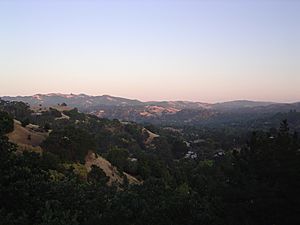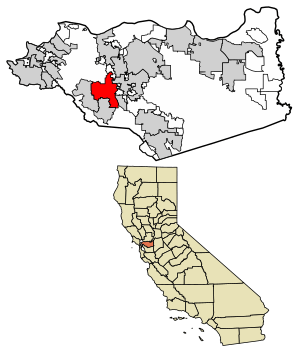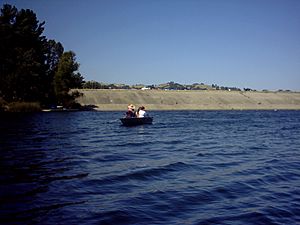Lafayette, California facts for kids
Quick facts for kids
City of Lafayette
|
|
|---|---|

A view of Lafayette, California
|
|

Location of Lafayette in Contra Costa County, California
|
|
| Country | |
| State | |
| County | Contra Costa |
| Settled | 1848 |
| Founded | 1857 |
| Incorporated | July 29, 1968 |
| Area | |
| • Total | 15.21 sq mi (39.39 km2) |
| • Land | 15.04 sq mi (38.95 km2) |
| • Water | 0.17 sq mi (0.43 km2) 1.08% |
| Elevation | 320 ft (97.5 m) |
| Population
(2020)
|
|
| • Total | 25,391 |
| • Density | 1,669.4/sq mi (644.61/km2) |
| Time zone | UTC−8 (PST) |
| • Summer (DST) | UTC−7 (PDT) |
| ZIP Code |
94549
|
| Area code(s) | 925 |
| FIPS code | 06-39122 |
| GNIS feature IDs | 277535, 2411591 |
Lafayette (formerly La Fayette) is a city in Contra Costa County, California, United States. In 2020, about 25,391 people lived there. The city was named after the Marquis de Lafayette, a French military officer. He was a hero who helped America win its independence during the American Revolutionary War.
Contents
Exploring Lafayette's Past
Before Spanish settlers arrived, the area where Lafayette now stands was home to Native American tribes. The Saclan tribe of the Bay Miwok lived here. Some Ohlone people also lived along Lafayette Creek.
Early European Contact
Europeans first met these tribes in the late 1700s. This happened when Catholic missions were built nearby. Sadly, these meetings often led to fighting. A battle even took place in Lafayette in 1797 between the Saclan and the Spanish. Eventually, the native people were taken over by the Spanish.
Mexican Land Grant
Most of Lafayette was once part of a Mexican land grant called Rancho Acalanes. This land was given to Candelario Valencia in 1834. The name "Acalanes" might have come from a local native village called Ahala-n.
American Settlement and Growth
American settlers began arriving in 1846. Elam Brown came from St. Joseph, Missouri, and bought Rancho Acalanes in 1848. The town grew quickly because it was close to San Francisco. By 1852, 76 people lived here, up from Brown's first group of 18 settlers. Brown also built a mill in 1853.
Milo J. Hough, one of Brown's original settlers, built a hotel in 1853. He also became the postmaster for the Acelanus post office in 1854. This post office closed the next year.
Developing Schools
Lafayette's first school opened in 1852 in a single room. Benjamin Shreve, a 25-year-old teacher, taught there. By 1865, the school had 43 students. A new schoolhouse was built in 1868 using $1,000 from a tax. The school year also grew longer. In 1893, another new school was built, which still stands today.
How Lafayette Got Its Name
On March 2, 1857, the LaFayette post office was officially created. Before this, the community had many unofficial names. These included Dog Town, Brown's Corner, and Alcalanus.
Benjamin Shreve, who owned a hotel and general store, applied for the post office. He first asked for the name Centerville. But another town in California already had that name. So, Shreve suggested "La Fayette," honoring the French general. The first post office was at 3535 Plaza Way. Shreve was the town's first long-term postmaster, serving for 30 years.
Changes in Spelling
The original document from 1857 spelled the name "LaFayette" as one word with a capital "F." By 1864, maps showed it as "Lafayette." Over the years, the spelling changed back and forth between "La Fayette" and "Lafayette." Finally, on March 31, 1932, the post office officially became "Lafayette." This spelling has stayed the same ever since. Lafayette was the tenth post office in Contra Costa County.
Modern Lafayette
In the early 1860s, Lafayette was a brief stop for the Pony Express. In the mid-1900s, Lafayette changed from a farming village to a commuter town. It became an official city in 1968.
Lafayette's Location and Environment
Lafayette is located in the San Francisco Bay Area of California. It has its own station on the BART public train system. Lafayette is found between Walnut Creek, Moraga, and Orinda. These three towns are often called "Lamorinda" by locals.
The city covers about 15.4 square miles (39.9 square kilometers). Most of this is land, with a small amount of water.
Lafayette's Climate
Lafayette is separated from Berkeley and Oakland by the Berkeley Hills. The Caldecott Tunnel runs under these hills. This natural boundary creates different weather patterns.
Lafayette has a Mediterranean climate, meaning it has warm, dry summers and cool, wet winters. In summer, temperatures can be much hotter in Lafayette than in cities closer to the bay. Summers are very sunny, though mornings can be foggy. Winters are cool and damp, with some freezing temperatures. Most rain falls in winter, but there are still many clear days.
The highest temperature ever recorded in Lafayette was 115°F (46°C) in July 1972. The lowest was 19°F (-7°C) in December 1990.
| Climate data for Lafayette, California | |||||||||||||
|---|---|---|---|---|---|---|---|---|---|---|---|---|---|
| Month | Jan | Feb | Mar | Apr | May | Jun | Jul | Aug | Sep | Oct | Nov | Dec | Year |
| Record high °F (°C) | 71 (22) |
80 (27) |
88 (31) |
98 (37) |
104 (40) |
110 (43) |
115 (46) |
107 (42) |
108 (42) |
103 (39) |
82 (28) |
74 (23) |
115 (46) |
| Mean daily maximum °F (°C) | 54 (12) |
60 (16) |
64 (18) |
71 (22) |
78 (26) |
84 (29) |
87 (31) |
87 (31) |
83 (28) |
75 (24) |
63 (17) |
55 (13) |
72 (22) |
| Mean daily minimum °F (°C) | 39 (4) |
42 (6) |
44 (7) |
46 (8) |
50 (10) |
54 (12) |
55 (13) |
55 (13) |
54 (12) |
49 (9) |
43 (6) |
39 (4) |
48 (9) |
| Record low °F (°C) | 20 (−7) |
26 (−3) |
29 (−2) |
29 (−2) |
34 (1) |
31 (−1) |
41 (5) |
42 (6) |
40 (4) |
34 (1) |
25 (−4) |
19 (−7) |
19 (−7) |
| Average precipitation inches (mm) | 4.25 (108) |
3.81 (97) |
3.24 (82) |
1.04 (26) |
.46 (12) |
.12 (3.0) |
.02 (0.51) |
.08 (2.0) |
.24 (6.1) |
.94 (24) |
2.59 (66) |
2.79 (71) |
19.58 (497.61) |
| Source: Intellicast | |||||||||||||
The area east of the hills is known for its suburban feel and rolling, grassy hills. The Lafayette Reservoir is in the southwest part of the city. Briones Regional Park extends into northern Lafayette. The local wildlife includes different types of forests, like mixed woods and oak woodlands.
Lafayette's Population
| Historical population | |||
|---|---|---|---|
| Census | Pop. | %± | |
| 1960 | 7,114 | — | |
| 1970 | 20,484 | 187.9% | |
| 1980 | 20,837 | 1.7% | |
| 1990 | 23,501 | 12.8% | |
| 2000 | 23,908 | 1.7% | |
| 2010 | 23,893 | −0.1% | |
| 2020 | 25,391 | 6.3% | |
| U.S. Decennial Census | |||
In 2010, Lafayette had a population of 23,893 people. Most residents (84.7%) were White. About 9% were Asian, and 5.8% were of Hispanic or Latino background.
The population is spread out in terms of age. About 24.9% of residents were under 18 years old. About 16.6% were 65 years or older. The average age in Lafayette was 45.2 years.
Arts and Culture in Lafayette
Local Library
The Lafayette Library and Learning Center is part of the Contra Costa County Library system. It's a great place for reading and learning.
Cross of Lafayette Memorial

A special memorial is located on a hill overlooking the Lafayette BART station and Highway 24. In November 2006, people started placing crosses there. These crosses honor American soldiers who have died in the Iraq War. By January 2014, there were about 6,000 crosses. A large sign also shows the total number of deaths. This memorial is on private property.
Lafayette Park Theater
The Park Theater is another historic site in Lafayette. It first opened in 1941 as a movie theater. It closed in 2005. The theater is near a statue of Marquis de Lafayette. There are now efforts to reopen the Park Theater for movies and other events.
Education in Lafayette
Most of Lafayette is served by the Lafayette Elementary School District. A small part is in the Orinda Union Elementary School District. All of Lafayette is part of the Acalanes Union High School District.
Public Schools
- Lafayette Elementary School
- Burton Valley Elementary
- Happy Valley Elementary School
- Springhill Elementary School
- Stanley Middle School
- Acalanes High School
Private Schools
- The Springstone School (middle and high school)
- Contra Costa Jewish Day School
- Chabad Hebrew School of Lamorinda
- St. Perpetua School
- The Meher Schools (preschool and elementary school)
Notable People from Lafayette
Many interesting people have lived in Lafayette, both in the past and present.
Past Residents
- Don Agrati: An actor and musician known for My Three Sons.
- Jon-Erik Beckjord: A researcher of paranormal topics like Bigfoot.
- Mona Beaumont: A French-born American painter.
- Frank DeVol: A composer and conductor.
- Henry J. Kaiser: A famous industrialist who built Hoover Dam and created Kaiser Permanente.
- Daniel E. Koshland Jr.: A biochemist and former editor of Science magazine.
- Brent Mydland: A musician.
- Buster Posey: A Major League Baseball catcher for the San Francisco Giants.
- Hideo Sasaki: An American landscape architect.
- Glenn T. Seaborg: A Nobel Prize-winning chemist who helped discover Plutonium. Element 106, Seaborgium, is named after him.
- Emilio Segrè: An Italian physicist and Nobel laureate who discovered technetium and astatine.
- Alexander Shulgin: A chemist known for discovering many psychoactive compounds.
- Charles Tickner: An Olympic bronze medalist in figure skating.
Present Residents
- Cam: A singer and songwriter, known for "Burning House."
- Natalie Coughlin: A gold medal-winning swimmer in the Olympics.
- Wayne Ferreira: A South African tennis player.
- Will Forte: An actor, writer, and comedian from Saturday Night Live.
- Justin Fox: A financial journalist and writer.
- Daniel Horowitz: A well-known attorney.
- Brad Lackey: A former professional motorcycle racer and World Champion.
- Beau Levesque: An assistant coach for the Los Angeles Lakers.
- William Shurtleff: A writer and historian focused on soyfoods.
See also
 In Spanish: Lafayette (California) para niños
In Spanish: Lafayette (California) para niños



